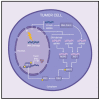The Impact of Radiation-Induced DNA Damage on cGAS-STING-Mediated Immune Responses to Cancer
- PMID: 33238631
- PMCID: PMC7700321
- DOI: 10.3390/ijms21228877
The Impact of Radiation-Induced DNA Damage on cGAS-STING-Mediated Immune Responses to Cancer
Abstract
Radiotherapy is a major modality used to combat a wide range of cancers. Classical radiobiology principles categorize ionizing radiation (IR) as a direct cytocidal therapeutic agent against cancer; however, there is an emerging appreciation for additional antitumor immune responses generated by this modality. A more nuanced understanding of the immunological pathways induced by radiation could inform optimal therapeutic combinations to harness radiation-induced antitumor immunity and improve treatment outcomes of cancers refractory to current radiotherapy regimens. Here, we summarize how radiation-induced DNA damage leads to the activation of a cytosolic DNA sensing pathway mediated by cyclic GMP-AMP (cGAMP) synthase (cGAS) and stimulator of interferon genes (STING). The activation of cGAS-STING initiates innate immune signaling that facilitates adaptive immune responses to destroy cancer. In this way, cGAS-STING signaling bridges the DNA damaging capacity of IR with the activation of CD8+ cytotoxic T cell-mediated destruction of cancer-highlighting a molecular pathway radiotherapy can exploit to induce antitumor immune responses. In the context of radiotherapy, we further report on factors that enhance or inhibit cGAS-STING signaling, deleterious effects associated with cGAS-STING activation, and promising therapeutic candidates being investigated in combination with IR to bolster immune activation through engaging STING-signaling. A clearer understanding of how IR activates cGAS-STING signaling will inform immune-based treatment strategies to maximize the antitumor efficacy of radiotherapy, improving therapeutic outcomes.
Keywords: DNA damage; antitumor immunity; cGAS–STING signaling; cancer; nucleic acid sensing; radiation; type I interferon.
Conflict of interest statement
The authors declare no conflict of interest. The funders had no role in the design of the study; in the collection, analyses, or interpretation of data; in the writing of the manuscript, or in the decision to publish the results.
Figures



Similar articles
-
Role of the cGAS-STING pathway in radiotherapy for non-small cell lung cancer.Radiat Oncol. 2023 Sep 4;18(1):145. doi: 10.1186/s13014-023-02335-z. Radiat Oncol. 2023. PMID: 37667279 Free PMC article. Review.
-
STING-Dependent Cytosolic DNA Sensing Promotes Radiation-Induced Type I Interferon-Dependent Antitumor Immunity in Immunogenic Tumors.Immunity. 2014 Nov 20;41(5):843-52. doi: 10.1016/j.immuni.2014.10.019. Epub 2014 Nov 6. Immunity. 2014. PMID: 25517616 Free PMC article.
-
Comprehensive elaboration of the cGAS-STING signaling axis in cancer development and immunotherapy.Mol Cancer. 2020 Aug 27;19(1):133. doi: 10.1186/s12943-020-01250-1. Mol Cancer. 2020. PMID: 32854711 Free PMC article. Review.
-
The paradoxical role of radiation-induced cGAS-STING signalling network in tumour immunity.Immunology. 2023 Mar;168(3):375-388. doi: 10.1111/imm.13592. Epub 2022 Oct 25. Immunology. 2023. PMID: 36217274 Review.
-
Unveiling cGAS mechanisms: Insights into DNA damage and immune sensing in cancer.DNA Repair (Amst). 2025 Aug;152:103868. doi: 10.1016/j.dnarep.2025.103868. Epub 2025 Jul 9. DNA Repair (Amst). 2025. PMID: 40680482 Review.
Cited by
-
Biology of NSCLC: Interplay between Cancer Cells, Radiation and Tumor Immune Microenvironment.Cancers (Basel). 2021 Feb 12;13(4):775. doi: 10.3390/cancers13040775. Cancers (Basel). 2021. PMID: 33673332 Free PMC article. Review.
-
Reprogramming of myeloid cells and their progenitors in patients with non-medullary thyroid carcinoma.Nat Commun. 2022 Oct 18;13(1):6149. doi: 10.1038/s41467-022-33907-4. Nat Commun. 2022. PMID: 36257966 Free PMC article.
-
Chemical and Biomolecular Strategies for STING Pathway Activation in Cancer Immunotherapy.Chem Rev. 2022 Mar 23;122(6):5977-6039. doi: 10.1021/acs.chemrev.1c00750. Epub 2022 Feb 2. Chem Rev. 2022. PMID: 35107989 Free PMC article. Review.
-
High-dose radiation-induced immunogenic cell death of bladder cancer cells leads to dendritic cell activation.PLoS One. 2024 Sep 4;19(9):e0307024. doi: 10.1371/journal.pone.0307024. eCollection 2024. PLoS One. 2024. PMID: 39231199 Free PMC article.
-
Inorganic Nanoparticle Functionalization Strategies in Immunotherapeutic Applications.Biomater Res. 2024 Sep 25;28:0086. doi: 10.34133/bmr.0086. eCollection 2024. Biomater Res. 2024. PMID: 39323561 Free PMC article. Review.
References
Publication types
MeSH terms
Substances
Grants and funding
LinkOut - more resources
Full Text Sources
Medical
Research Materials

